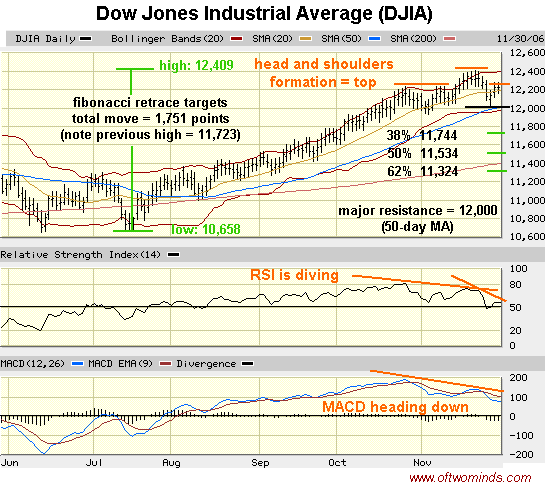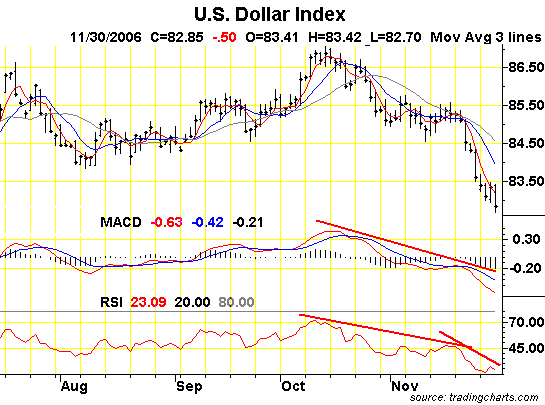

|
| weblog/wEssays archives | home | |
|
Part V: Is The Bull About to be Gored by the Dollar? (December 1, 2006) This Week's Theme: Beneath the Surface We began the week with a query from astute reader Jed H. on the market's direction: Are the Dow Industrials & the S&P500 "topping out" from a Bear Rally, OR will this ~ 4 year rise from ~ 2003 go on more until spring 2007? Jed H.Let's start with a 6-month chart of the Dow Jones Industrial Average: 
A quick glance reveals a market in decline. First, there is a classic "head and shoulders" formation, indicating the near-term top is in (12,409). RSI (relative strength) is diving, and MACD (moving average convergence-divergence) has been heading down since late October, presaging the current decline. Despite a heroic volume of over 4 billion shares traded on Thursday, Nov. 30, the DJIA ended down--a bearish signal. For comparison, average daily volume is around 2.5 billion shares. The only day on which volume ran close to 4 billion was October 16 (3.9 billion)--a down day. Interestingly, the high of the day was 11,996; the market ran into severe resistance at 12,000. It finally closed over 12,000 on october 19, but with only 2.6 billion shares traded. On November 9, the DJIA chalked up a 3 billion-share day--another down day. November 14 was an up day--the only up day which touched 3 billion shares. Why is volume analysis important? Because volumes indicate trends just like prices, and they also establish resistance levels. For the DJIA to trade a monumental 4 billion shares--an astonishing 25% higher than any previous day's volume in this long uptrend--and fail to close higher is extremely bearish. Despite their stupendous efforts, the Bulls failed to eke out a gain for the day. This is another way of saying, "Look out below!" Next, we turn to a simple fibonacci analysis for some downwind targets. Nothing is etched in stone, of course, but markets often bounce around a fibonacci number. In this case, the 38% retrace target of 11,744 is virtually identical with the DJIA's previous multi-year high water mark of 11,723. That will prove strong support. If the DJIA fails to hold 11,723, then next stop is the 50% retracement at 11,534. Below that, the 200-day moving average at around 11,400 should provide support. If that fails, then the 62% retrace target is 11,324--a 1,085 point drop from the November 21 high. A 686-point retracement to the previous high (now support) would not mean the Bull Market is over. Retracements are normal in any Bull Market. After completing this retracement, the DJIA could work its way to new heights; chartist Rick Ackerman (Rick's Picks in the right-hand column of links) has pegged 13,045 as a potential upside target for the DJIA. Will it reach this? There's no way to know at this time; but we can look for some help in what happens to the dollar. 
As you can see, MACD and RSI are in steep downtrends, with no bottom in sight. There is a sense of complacency about the dollar, at least in the financial media; no one seems worried that it could break through the "Gate of Doom" level of 80. If it holds, perhaps the DJIA can work its way into an uptrend in Q1 2007. But if it breaks down below the multi-year support at 80, then all bullish bets are off. For more on this subject and a wide array of other topics, please visit my weblog. copyright © 2006 Charles Hugh Smith. All rights reserved in all media. I would be honored if you linked this wEssay to your site, or printed a copy for your own use. |
||
| weblog/wEssays | home |